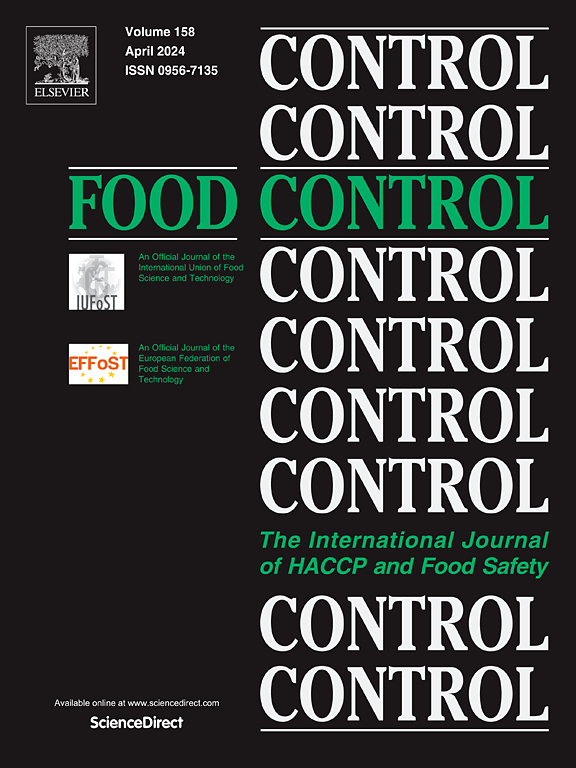Metabolomics based on GC-MS combined with chemometrics for geographical discrimination of garlic (Allium sativum L.)
IF 5.6
1区 农林科学
Q1 FOOD SCIENCE & TECHNOLOGY
引用次数: 0
Abstract
Ensuring the geographic origin of products helps protect consumers against fraud and mislabeling. This study investigates the metabolomic profiles of garlic (Allium sativum L.) samples from Brazil and China using gas chromatography-mass spectrometry (GC-MS). Multivariate analysis Partial Least Squares Discriminant Analysis (PLS-DA) and Orthogonal PLS-DA (Ortho PLS-DA) revealed clear metabolic distinctions between the two sample groups with high classification accuracy. Brazilian garlic samples showed higher levels of sulfur compounds, such as allyl propyl sulfide, cysteine sulfonic acid, and S-carboxymethyl-L-cysteine, which contribute to its pungency and potential health benefits. Amino acids L-arginine, L-glutamic acid, and L-cysteine were also significantly increased in garlic from Brazil. In contrast, Chinese garlic exhibited higher intensities of sugars (e.g., D-fructose, D-mannose) and essential amino acids (L-tryptophan, L-valine, and L-leucine). These differences in metabolism are the result of distinct metabolic profiles. GC-MS-based untargeted metabolomic and chemometric analysis were able to differentiate the geographical origin of Brazilian and Chinese garlics and remain valuable to food authentication and quality control. Further studies are needed to confirm the biomarkers for origin verification here stated.

基于气相色谱-质谱联用化学计量学的代谢组学在大蒜(Allium sativum L.)地理鉴别中的应用
确保产品的地理来源有助于保护消费者免受欺诈和错误标签的侵害。本研究采用气相色谱-质谱法(GC-MS)对巴西和中国的大蒜(Allium sativum L.)样品进行了代谢组学分析。多元分析部分最小二乘法判别分析(PLS-DA)和正交 PLS-DA(Ortho PLS-DA)显示,两组样品之间的代谢差异明显,分类准确率高。巴西大蒜样品显示出较高水平的硫化合物,如烯丙基丙基硫醚、半胱氨酸磺酸和 S-羧甲基-L-半胱氨酸,这有助于其辛辣味和潜在的健康益处。巴西大蒜中的氨基酸 L-精氨酸、L-谷氨酸和 L-半胱氨酸也显著增加。相比之下,中国大蒜中糖类(如 D-果糖、D-甘露糖)和必需氨基酸(L-色氨酸、L-缬氨酸和 L-亮氨酸)的含量较高。这些代谢差异是不同代谢特征的结果。基于气相色谱-质谱(GC-MS)的非靶向代谢组学和化学计量学分析能够区分巴西大蒜和中国大蒜的地理来源,对食品鉴定和质量控制仍有价值。还需要进一步的研究来确认本文所述的原产地验证生物标志物。
本文章由计算机程序翻译,如有差异,请以英文原文为准。
求助全文
约1分钟内获得全文
求助全文
来源期刊

Food Control
工程技术-食品科技
CiteScore
12.20
自引率
6.70%
发文量
758
审稿时长
33 days
期刊介绍:
Food Control is an international journal that provides essential information for those involved in food safety and process control.
Food Control covers the below areas that relate to food process control or to food safety of human foods:
• Microbial food safety and antimicrobial systems
• Mycotoxins
• Hazard analysis, HACCP and food safety objectives
• Risk assessment, including microbial and chemical hazards
• Quality assurance
• Good manufacturing practices
• Food process systems design and control
• Food Packaging technology and materials in contact with foods
• Rapid methods of analysis and detection, including sensor technology
• Codes of practice, legislation and international harmonization
• Consumer issues
• Education, training and research needs.
The scope of Food Control is comprehensive and includes original research papers, authoritative reviews, short communications, comment articles that report on new developments in food control, and position papers.
 求助内容:
求助内容: 应助结果提醒方式:
应助结果提醒方式:


